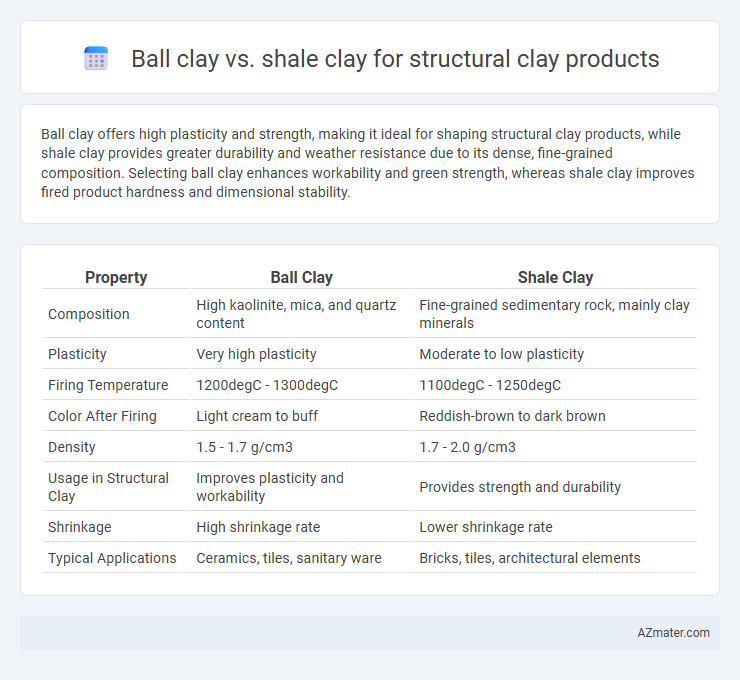Ball clay offers high plasticity and strength, making it ideal for shaping structural clay products, while shale clay provides greater durability and weather resistance due to its dense, fine-grained composition. Selecting ball clay enhances workability and green strength, whereas shale clay improves fired product hardness and dimensional stability.
Table of Comparison
| Property | Ball Clay | Shale Clay |
|---|---|---|
| Composition | High kaolinite, mica, and quartz content | Fine-grained sedimentary rock, mainly clay minerals |
| Plasticity | Very high plasticity | Moderate to low plasticity |
| Firing Temperature | 1200degC - 1300degC | 1100degC - 1250degC |
| Color After Firing | Light cream to buff | Reddish-brown to dark brown |
| Density | 1.5 - 1.7 g/cm3 | 1.7 - 2.0 g/cm3 |
| Usage in Structural Clay | Improves plasticity and workability | Provides strength and durability |
| Shrinkage | High shrinkage rate | Lower shrinkage rate |
| Typical Applications | Ceramics, tiles, sanitary ware | Bricks, tiles, architectural elements |
Introduction to Structural Clay Products
Structural clay products, such as bricks and tiles, rely on specific raw materials like ball clay and shale clay for optimal performance. Ball clay provides excellent plasticity and strength, enhancing moldability and fired strength, while shale clay offers high durability and resistance to weathering due to its fine-grained sedimentary composition. Selecting the appropriate clay type directly impacts the structural integrity, water absorption, and overall quality of clay-based construction materials.
What is Ball Clay?
Ball clay is a highly plastic, fine-grained sedimentary clay composed mainly of kaolinite, mica, and quartz, valued for its exceptional plasticity and firing properties in structural clay products such as bricks and tiles. It contains a higher proportion of organic matter and binds well with other clays, enhancing the strength, smoothness, and green strength of ceramic bodies. In comparison, shale clay is a harder, less plastic material that requires more processing to achieve similar workability and durability in structural applications.
What is Shale Clay?
Shale clay, a fine-grained sedimentary rock composed primarily of compacted silt and clay particles, exhibits distinct plasticity and firing characteristics crucial for structural clay products. Unlike ball clay, shale clay typically contains higher levels of silica and alumina, contributing to increased strength and durability in bricks and tiles after firing. Its mineral composition enhances shrinkage control and resistance to weathering, making it a preferred raw material in producing high-quality structural clay units.
Mineral Composition: Ball Clay vs Shale Clay
Ball clay is predominantly composed of kaolinite (20-80%), mica, and quartz, providing fine particle size and plasticity essential for structural clay products. Shale clay mainly contains illite and mixed-layer illite-smectite with variable amounts of quartz and feldspar, resulting in lower plasticity but higher fired strength. The mineral distinction influences workability and durability, with ball clay offering superior plasticity and shale clay contributing to mechanical strength in fired structural ceramics.
Plasticity and Workability Comparison
Ball clay exhibits higher plasticity compared to shale clay, making it more suitable for structural clay products that require extensive molding and shaping. Its fine particle size and high organic content contribute to superior workability, allowing easier handling and forming during manufacturing processes. In contrast, shale clay's lower plasticity and coarser texture result in reduced workability, often requiring blending with more plastic materials to achieve desired structural properties.
Firing Characteristics and Temperature Effects
Ball clay exhibits superior plasticity and finer particle size compared to shale clay, resulting in better workability and uniform drying for structural clay products. During firing, ball clay vitrifies at lower temperatures around 1100-1150degC, enhancing strength and dimensional stability, whereas shale clay requires higher firing temperatures near 1200-1250degC to achieve similar vitrification. The lower firing temperature of ball clay reduces energy consumption and minimizes warping or cracking risks in structural clay components.
Mechanical Strength in Finished Products
Ball clay exhibits higher plasticity and finer particle size compared to shale clay, resulting in improved workability and compaction in structural clay products. Shale clay, with its layered structure and lower plasticity, typically offers greater mechanical strength and durability after firing, making it preferable for load-bearing applications. Finished products made from shale clay generally demonstrate enhanced compressive strength and resistance to weathering compared to those using ball clay.
Color and Surface Finish Outcomes
Ball clay offers a smoother surface finish and lighter color, ideal for producing bright, high-quality structural clay products with fine detail. Shale clay typically yields a darker, more variegated color and a rougher texture, contributing to rustic or industrial aesthetic finishes. Color consistency and surface smoothness in structural clay products are more easily achieved with ball clay due to its higher plasticity and finer particle size.
Cost and Availability Considerations
Ball clay offers higher plasticity and strength for structural clay products but tends to have a higher cost due to limited deposits and intensive processing requirements. Shale clay is more abundant and generally less expensive, providing cost-effective options for large-scale production despite lower plasticity. Availability of local sources significantly influences the economic choice between ball clay and shale clay in structural applications.
Best Uses: Selecting the Right Clay for Structural Applications
Ball clay offers exceptional plasticity and strength, making it ideal for high-quality structural clay products like bricks, tiles, and pipes that require durability and fine finish. Shale clay, characterized by lower plasticity and higher silica content, suits applications demanding structural stability but less formability, such as certain roofing tiles and wall units. Selecting the right clay depends on the need for workability versus strength, with ball clay preferred for intricate shapes and shale clay used where compressive strength is paramount.

Infographic: Ball clay vs Shale clay for Structural clay product
 azmater.com
azmater.com